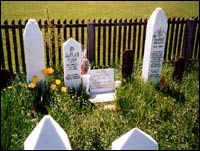Command Responsibility
Payam Akhavan arrived in Ahmici days after the massacre— to investigate for the UN High Commissioner for Human Rights. He later worked at the ICTY as a legal adviser. In looking for the "big fish" responsible for troops in the region, Akhavan discovered evidence to support a principal developed at Nuremberg: command responsibility.
"When you're dealing with military commanders and leaders, it's not the particular acts but it's the criminal design or plan," says Akhavan.
The concept of command responsibility allows prosecutors to charge officers for the crimes of their subordinates, even if there is no direct evidence that the commanders ordered killings or other illegal acts. One important element for prosecutors was establishing a pattern of crimes that took place over a significant period of time.
| |

Graves of Ahmici victims. Photo: M. Montgomery / American RadioWorks |
"If you're a commander in effective control and your subordinates, over several weeks or several months, are committing these massive military operations involving atrocities, it is inconceivable that, unless you're a purely symbolic commander, that you have not ordered or instigated these crimes," says Akhavan.
Within days of the attack on Ahmici, villagers told Akhavan and other investigators that the attacking force of about 100 soldiers wore the insignia of the HVO, the Bosnian Croat army. So Akhavan paid a visit to the regional HVO colonel, a man named Tihomir Blaksic.
Akhavan recalls: "I repeatedly asked him, 'Are you the commander of HVO forces in the region?' To which he answered yes. 'Are you in control of this area?' To which he answered yes. And I said, 'How could a company size group of soldiers, a hundred to hundred and fifty soldiers engage is a several hour-long assault on a village, involving several hundred casualties, involving mortars and machine guns and so on. How could you not know about it?'"
Blaksic's office was just two miles from Ahmici, but the commander claimed he had no idea who carried out the attack. With no physical evidence to tie Blaskic to the massacre, prosecutors largely relied on the doctrine of command authority to prosecute the Bosnian Croat commander. Investigator Payam Akhavan's interview turned out to be important evidence for the prosecution.
"I did mention that they would be held responsible if they did not investigate these atrocities and bring those responsible to justice," says Akhavan.
So while Akhavan's interview did not prove that Blaskic ordered the attack, it established that the colonel knew about the atrocities shortly afterward and had time to follow up.
"Inadvertently we stumbled on a very convenient means of putting commanders on notice and avoiding any pretext on their part of saying that they were somehow unaware of what their subordinates were doing," says Akhavan.
Command responsibility, or "superior authority" as it applies to civilian leaders, is at the heart of many ICTY prosecutions, including the current trial of the former Serbian leader, Slobodan Milosevic. Though it has proven effective in securing convictions, the strategy requires a complex web of circumstantial evidence and often the testimony of hundreds of witnesses. This is one reason many trials at The Hague tribunal drag on for years.
Prosecuting leaders and commanders for crimes they may not have known about (but failed to prevent or punish) largely satisfies justice in The Hague. In part, this is because war crimes courts since Nuremberg have held that leaders who make policy and issue orders hold greater responsibility than subordinates who carry out those plans.
However, this approach is sometimes at odds with the needs of victims, according to Eric Stover, director of the Human Rights Center at University of California at Berkeley. As part of a multi-year study, Stover interviewed nearly 100 victims who testified at The Hague. Whether Serbs, Croats and Muslims—the feelings they expressed were strikingly similar.
Stover says these victims expressed a desire for a more personal kind of justice: "'I want to sit in the same room as those people who did this within our village and I want to ask them why did you do this. We had such a good life before.' And for many of them, it's that quest, it's trying to understand how their villages could be destroyed so quickly. And that is far more important than the more abstract notions of achieving justice and getting the bigger fish."
Judgment for Ahmici
In early 2000, the court began issuing the first judgments against Bosnian Croats for Ahmici and other attacks.
The court convicted Tihomir Blaksic of murder, forced deportation and other crimes against humanity because he knew about the crimes but ignored his obligation to investigate. The court sentenced Blaksic to 45 years in prison.
As for the Kupreskic brothers, the tribunal ruled there was not enough evidence for a murder conviction but it did sentence them to ten years in prison for essentially aiding and abetting the attack.
But late last year, an ICTY appeals chamber overturned the conviction in part due to a lack of credible testimony. The brothers were released. And they were not alone: Of the 11 Bosnian Croats originally accused of directly participating in the attack on Ahmici, eight were either released or had indictments withdrawn.
"It was very depressing," recalls Albert Moskowitz, who has returned to the Justice Department. "I spent so much time bringing witnesses in and persuading them to come and testify and only to have the convictions reversed, I felt very bad for the community and victims who had come forward."
Tihomir Blaksic and Dario Kordic, a Bosnian Croat politician sentenced to 25 years, appealed the convictions. Lawyers for Blaksic say newly discovered documents from Bosnian Croat archives show that the former commander tried to punish subordinates for attacks on civilians, but was blocked by superior officers and politicians.
Next: A Divided Community 

